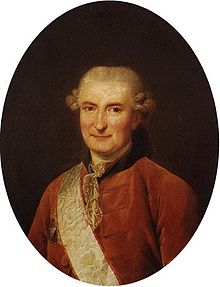Ove Høegh-Guldberg
Ove Høegh-Guldberg | |
|---|---|
 | |
| Privy Councillor of Denmark | |
| Predecessor | Johann Friedrich Struensee |
| Successor | Andreas Peter Bernstorff |
| Born | Ove Guldberg 1 September 1731 Horsens, Jutland, Denmark |
| Died | 7 February 1808 (aged 76) Hald Manor in Viborg, Denmark |
| Spouse(s) | Cathrine Marie Nørlem
(m. 1762–1763)Lucie Emmerentze Nørlem
(m. 1769–1807) |
| Issue | Juliane Marie Høegh-Guldberg Frederik Hoegh Guldberg Peter Hoegh Guldberg Christian Hoegh Guldberg Julius Høegh-Guldberg |
Ove Høegh-Guldberg (born Guldberg; 1 September 1731 – 7 February 1808) was a Danish statesman, historian, and de facto prime minister of Denmark during the reign of the mentally unstable King Christian VII. [1]
Biography

Guldberg was born at
In 1764 he was connected to Queen
After the fall of Struensee in 1772, Guldberg became the leader of the new government. Not formally designated a
The 'Guldberg Rule' was marked by peace and rest, and initially by good economic conditions. Høegh-Guldberg's foreign policy was decidedly peaceful even to Sweden. As a neutral state,
Guldberg also supported gifted Danish poets and authors, including
An economic downturn after the end of the American Revolutionary War undermined his popularity, but more importantly like his royal employers Queen Dowager Juliana Maria and Frederick, Hereditary Prince of Denmark, he had fallen badly out with the Crown Prince (afterwards Frederick VI) whose growing opposition he seems to have ignored. In April 1784, just as he had been appointed a minister, he was forced to resign following the Crown Prince's coup d'état. He was then reduced to the rank of senior official (amtmand) until 1802. He retired to Hald Manor (Hald Hovedgaard) in Viborg which he had purchased in 1798. [6]
Personal life
He was first married in 1762 with Cathrine Marie Nørlem (1736-1763), daughter of trustee at Bygholm Peder Jensen Nørlem (1680-1738 ) and Christentze Hansdatter Lessow (1701-1769). He was married a second time in 1769 to Lucie Emmerentze Nørlem (1738-1807), sister of his first wife.
He was the father of military officer Julius Høegh-Guldberg (1779–1861) and grandfather of artist Emmerik Høegh-Guldberg (1807–1881).[7][8]
Ove Høegh-Guldberg had a number of direct descendants, including his namesake, the Australian biologist Ove Hoegh-Guldberg.
See also
References
- ^ "Ove Høegh-Guldberg". Nordisk familjebok. Retrieved October 1, 2019.
- ^ "Johann Friedrich Struensee". guidedhistory. Retrieved October 1, 2019.
- ^ "Zoega, Georg (Jørgen), 1755-1809". Dansk biografisk Lexikon. Retrieved October 1, 2019.
- ^ "Schimmelmann, Heinrich Carl Greve, 1724-82". Dansk biografisk Lexikon. Retrieved October 1, 2019.
- ^ Ole Feldbæk. "A.P. Bernstorff". Den Store Danske, Gyldendal. Retrieved October 1, 2019.
- ^ "Om Hald Hovedgaard". Det Danske Forfatter- og Oversættercenter. Retrieved October 1, 2019.
- ^ "Julius Høegh-Guldberg". AarhusWiki. Retrieved October 1, 2019.
- ^ "Emmerik Lucian Høegh-Guldberg". AarhusWiki. Retrieved October 1, 2019.
Other sources
- Sven Cedergreen Bech, 1965 Politikens Danmarkshistorie, vol. 9
- Jens Vibæk, 1964 Politikens Danmarkshistorie, vol. 10
- Ole Feldbæk, 2003 Gyldendal og Politikens Danmarkshistorie, vol. 9
- Edvard Holm, 1906 Danmark-Norges Historie vol. 5
